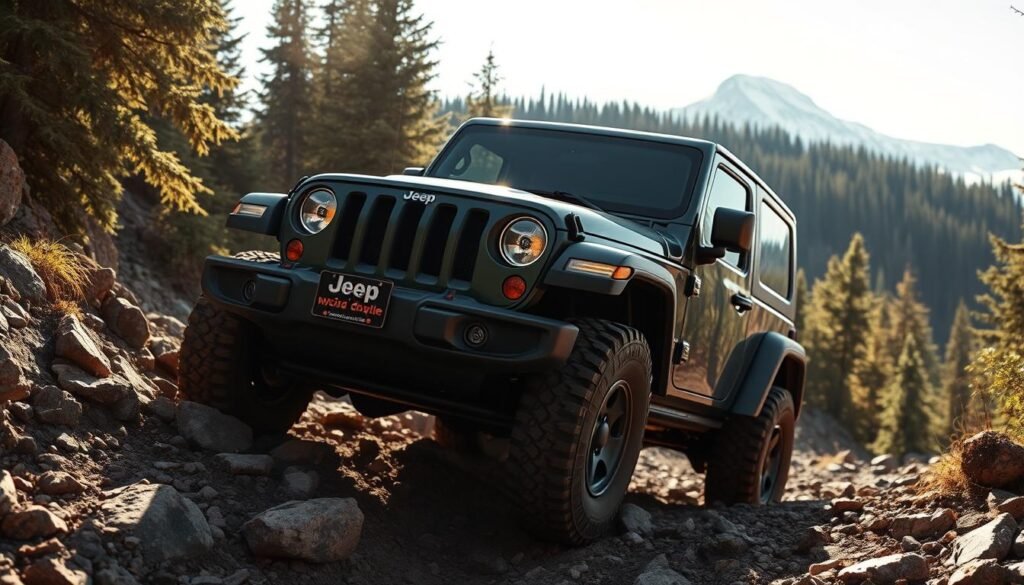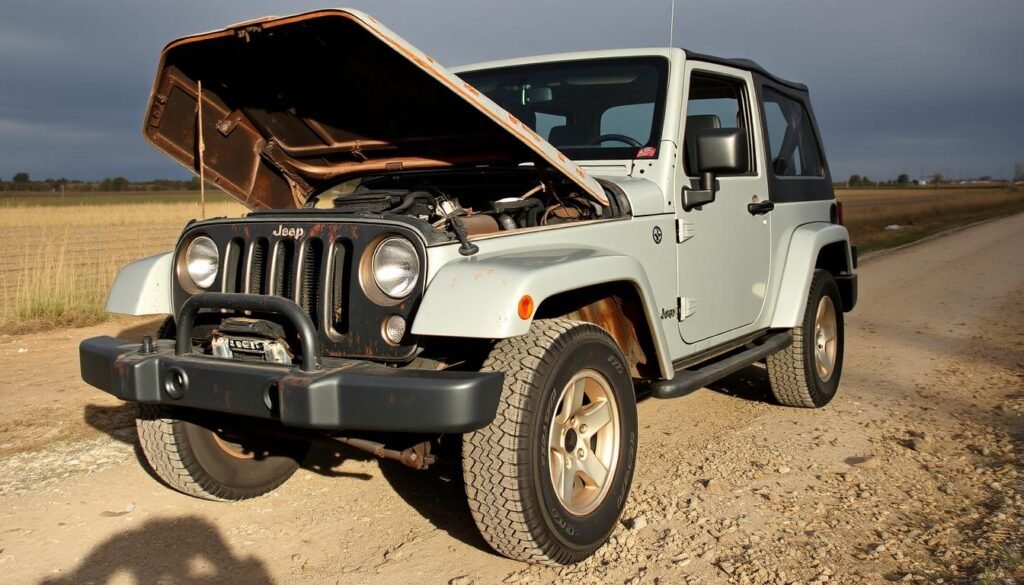“Adventure is worthwhile in itself,” said Amelia Earhart. This perfectly captures the Jeep Wrangler’s spirit. It’s not just a car; it’s a reliable friend for long trips.
The Jeep Wrangler is known for its durability. It can last up to 400,000 miles. Most owners enjoy theirs for 15 to 20 years, driving about 12,000 to 15,000 miles a year.
With regular care, a Wrangler can go strong for 200,000 to 300,000 miles. This means it can be your trusted companion for almost two decades. The Wrangler’s lifespan is about making memories, not just numbers.
These cars are tough, handling city streets and mountain trails with ease. Knowing how long a Jeep Wrangler lasts helps you choose wisely. It’s a smart investment for years of adventure.
Understanding Jeep Wrangler’s Expected Lifespan
Jeep Wranglers are known for their long life and durability. They stand out in the SUV market. Wrangler mileage expectations are high, showing they can handle many driving conditions well.
Average Years of Service
A typical Jeep Wrangler can last 15 to 20 years with good care. Different trims have different lifespans:
- Sahara trim: Around 20 years
- Rubicon trim: 15-18 years
- Sport and Willys trims: 15-20 years
Typical Mileage Range
Wranglers are known for their high mileage. They can go from 200,000 to 300,000 miles easily. Some models have even hit over 400,000 miles with careful maintenance.
Lifespan Comparison with Other SUVs
| Vehicle Type | Average Lifespan | Typical Mileage |
|---|---|---|
| Jeep Wrangler | 15-20 years | 200,000-400,000 miles |
| Average SUV | 10-15 years | 150,000-250,000 miles |
Jeep Wranglers last longer than many SUVs. Robust construction and dedicated owner maintenance help them last longer.
Key Factors Affecting Wrangler Durability

Jeep Wrangler durability is shaped by several key factors. These factors help determine how well the vehicle performs over time. With a JD Power reliability score of 81 out of 100, these rugged vehicles show great resilience in different driving conditions.
Several key Jeep Wrangler durability factors significantly impact the vehicle’s lifespan:
- Maintenance Quality: Regular service and proactive repairs
- Driving Conditions: Off-road versus highway usage
- Environmental Exposure: Climate and terrain impacts
- Manufacturing Year: Variations in model design and engineering
Owners have a big role in making their Wrangler last longer. The average repair cost is $694, a bit higher than for compact SUVs. RepairPal rates the Wrangler’s reliability as 3 out of 5, which is above average.
Some durability challenges include:
- Automatic transmission problems
- Power module failures
- Exhaust manifold cracks
- Oil and water leaks
Despite these challenges, Jeep Wranglers are known for their remarkable endurance. Many owners report their vehicles running smoothly for over 200,000 miles. This shows the model’s strong engineering and its ability to last a long time.
Maintenance Requirements for Maximum Longevity
To make your Jeep Wrangler last longer, start with a good maintenance plan. Keeping your Wrangler in top shape can make it last up to 400,000 miles. This means more adventures on the road.
Essential Service Intervals
Regular maintenance is key to a long-lasting Wrangler. Here are some important service times:
- Oil changes every 5,000 miles or six months
- Brake pad inspections around 40,000 miles
- Suspension alignment yearly
- Shock absorber checks every 50,000 miles
Critical Components to Monitor
Some parts need extra care to avoid problems:
- Radiator: Look out for leaks
- Transmission: Watch out for issues in 2007-2014 models
- Undercarriage: Check for damage from off-roading
- Tire wear: Look for uneven wear patterns
Professional vs DIY Maintenance
Some tasks you can do yourself, but a pro can spot issues early. A mechanic can save you money and keep your Wrangler running strong.
A well-maintained Wrangler can serve you reliably for 15-20 years with proper care.
Common Mechanical Issues Over Time
Jeep Wranglers are famous for their tough design. But, like any car, they can face mechanical problems over time. Knowing about these issues helps owners keep their vehicles in top shape.
The “Death Wobble” is a big problem for Jeep Wranglers. It’s a violent shake in the steering at high speeds. This usually happens when the suspension parts wear out. It’s very dangerous and needs to be fixed quickly.
- Steering and Suspension Challenges
- Electrical System Malfunctions
- Transmission Performance Concerns
- Engine Reliability Variations
Wranglers from different years have different reliability scores. Early JK models (2007-2011) got about 6/10. But, recent JL models (2021-2024) scored an 8.5/10.
| Model Years | Primary Mechanical Issues | Reliability Score |
|---|---|---|
| 2007-2011 (Early JK) | Oil consumption, transmission slipping | 6/10 |
| 2012-2018 (Later JK) | Improved engine, fewer transmission problems | 7.5/10 |
| 2018-2020 (Early JL) | Reduced mechanical complaints | 8/10 |
| 2021-2024 (Recent JL) | Advanced safety features | 8.5/10 |
Owners should watch out for issues like water leaks, electrical problems, and worn-out steering parts. Regular maintenance is essential to avoid these problems and keep the vehicle running longer.
Model Year Reliability Comparison
Looking at Jeep Wrangler reliability by year, some years really shine. The most reliable years are 2018, 2015, 2010, 2003, and 1997. Each year has its own strengths in lasting well over time.

Older Wranglers, like the 1997 and 2003 models, are known for their simplicity. They have fewer electronic parts, which means fewer things can go wrong. But, some newer models faced their own set of problems.
- 2007-2008: Known for several mechanical issues
- 2012: Had many reliability concerns
- 2010-2018: Had problems with TRW crash sensors, raising safety worries
Some years had big reliability issues. The “Death Wobble” was a major problem for some owners. Also, issues with windows and airbags added to the trouble for certain models.
“A well-maintained Jeep Wrangler can easily surpass 200,000 miles with proper care,” automotive experts consistently report.
Despite some issues, the Jeep Wrangler is well-respected. RepairPal gives Jeep a 3.5 out of 5.0 for reliability, ranking 15th among 32 car brands. Owners might need to visit the shop about 0.3 times a year for repairs. The average cost for these repairs is $634 per year.
The reliability of Jeep Wranglers by year shows that some models are more reliable than others. But, the most important thing is regular maintenance. With the right care, many Wranglers can go over 280,000 miles and last up to 20 years.
Impact of Driving Habits on Wrangler Longevity

Your Jeep Wrangler’s life span depends a lot on how you drive it. The way you handle this iconic vehicle can greatly affect its life and performance. Different driving styles can either make the Wrangler last longer or shorter.
Key driving habits that influence Jeep Wrangler durability include:
- Terrain selection
- Driving intensity
- Maintenance consistency
- Environmental conditions
Driving habits are key to keeping your Wrangler in top shape. Highway driving typically preserves the vehicle better than aggressive off-road use. Wranglers driven mostly on highways can last over 300,000 miles. On the other hand, off-road models might see lifespans closer to 200,000 miles.
| Driving Style | Estimated Lifespan | Potential Wear Impact |
|---|---|---|
| Highway Driving | 300,000+ miles | Minimal Stress |
| Moderate Off-Road | 250,000 miles | Medium Stress |
| Aggressive Off-Road | 200,000 miles | High Stress |
Proper care and mindful driving can greatly improve your Wrangler’s life. Regular maintenance, gentle acceleration, avoiding sudden stops, and choosing the right terrains will help keep your vehicle in good shape.
“Your Jeep Wrangler is an investment. Treat it with respect, and it will serve you for years to come.” – Jeep Enthuasiast Magazine
High Mileage Maintenance Strategies
Jeep Wrangler high mileage maintenance needs careful planning and early action. Many Wrangler owners keep their vehicles running strong over 200,000 miles. They do this by sticking to a solid maintenance plan.
By knowing the right maintenance steps, owners can make their Wranglers last longer. It’s all about focusing on the parts that matter most for the vehicle’s performance.
Extended Life Components
Some parts are key to keeping a Jeep Wrangler running for years:
- Drivetrain systems
- Suspension components
- Transmission components
- Engine cooling systems
Preventive Care Techniques
Good Jeep Wrangler high mileage maintenance includes several key steps:
- Regular fluid checks and replacements
- Comprehensive inspection of critical systems
- Addressing problems early on
| Maintenance Task | Recommended Interval |
|---|---|
| Oil Changes | Every 5,000-7,500 miles |
| Tire Rotations | Every 5,000 miles |
| Tune-ups | Every 30,000 miles |
| Wheel Alignment | Every 6-12 months |
Preventive maintenance can help Wranglers go over 300,000 miles with the right care and attention.
Maximizing Your Wrangler’s Service Life
To make your Jeep Wrangler last longer, plan and maintain it well. These SUVs can go up to 200,000 to 300,000 miles with the right care. Regular checks and maintenance can help your Wrangler last longer.
Understanding your Wrangler’s needs is key. Experts suggest setting up service intervals based on your model and how you drive. The 4.0L Inline-6 and 3.6L V6 models are known for lasting a long time, sometimes over 400,000 miles.
Keeping up with maintenance is important. Change your oil every 3,000 to 5,000 miles and rotate your tires regularly. Off-road drivers should check their suspension and shock absorbers often. Following these steps and fixing problems early can keep your Wrangler running well.
Your Wrangler’s life span depends on maintenance, driving habits, and quick repairs. Proper care not only extends its life but also keeps its value and performance high.
FAQ
How many miles can a Jeep Wrangler typically last?
A Jeep Wrangler can go over 200,000 miles with the right care. Many owners see their Wranglers last well past 300,000 miles. This is thanks to regular maintenance and taking good care of the vehicle.
Are older Jeep Wrangler models more reliable than newer ones?
Older Wranglers are known for being simple and durable. Newer models have better technology and safety features. Each model has its own reliability strengths.
What maintenance is key for a long-lasting Wrangler?
Keeping up with oil changes, transmission fluid, and brake checks is essential. Fixing issues quickly is also important. Off-road Wranglers need more maintenance due to extra wear.
Do Jeep Wranglers hold their value over time?
Yes, Jeep Wranglers keep their value well. Their durability, iconic look, and strong fan base help them hold value better than many SUVs.
How do driving conditions affect a Wrangler’s lifespan?
Driving in extreme conditions can wear out a Wrangler faster. But, Wranglers are built to handle tough conditions better than many other vehicles.
What are the most common mechanical issues in Jeep Wranglers?
Issues include oil leaks, transmission problems, and electrical and suspension wear. Regular maintenance can help prevent or fix these problems.
Can a Jeep Wrangler be a good long-term investment?
Absolutely! With the right care, a Wrangler can be a great long-term vehicle. Their durability, strong resale value, and loyal owner community make them a solid choice.
How often should I service my Jeep Wrangler?
Follow the manufacturer’s service schedule, usually every 3,000-7,500 miles for oil changes. Do a full service every year. Off-road users might need more frequent checks.
Do modifications affect a Wrangler’s longevity?
Mods can impact longevity based on quality and how well they’re installed. Good upgrades can improve performance, but bad ones can stress the vehicle.
What makes Jeep Wranglers so durable?
Their body-on-frame design, simple mechanics, and focus on durability make them long-lasting. They’re built to handle tough conditions that would harm other vehicles.


